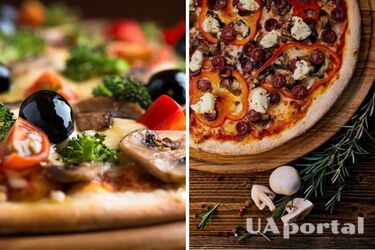Wholemeal base and the right toppings: how to make pizza healthier and less calorie-dense

Pizza is growing in popularity around the world. According to surveys, one in eight Britons prefers pizza when ordering takeaways, while young people prefer pizza to Indian or Chinese cuisine. However, nutritionist Harriet Lidgard says that if you love pizza, you don't have to give it up.
However, pizza does have one drawback: it contains a lot of calories due to its flour base and cheese topping. An American pizza contains about a thousand calories, and a Hawaiian pizza with crust and toppings contains 1344 calories. Thus, if you are watching your figure, pizza may not be the best choice.
Read also: How to make juicy pizza rolls
The Basics
If you love pizza but want to maintain a healthy lifestyle, there are some tips from a nutritionist to help you enjoy this dish without increasing your calorie intake.
For starters, choose a wholemeal base as it contains more fibre and nutrients than a white flour base. It will also help you feel fuller for longer and provide you with energy throughout the day. Thin-crust pizza has significantly fewer calories than thicker pizza, so it can also be a good option.
If you have a gluten intolerance or allergy, choose a gluten-free base that contains a combination of gluten-free flour (rice, potato starch) and tapioca flour.
Don't forget that a topped border contains a lot of cheese, so it's best to avoid it if you want to reduce the calorie content of your pizza. Of course, the topping adds flavour, but it is important not to overdo it and not to overstep the boundaries of a healthy diet.
Cheese
If you want to order a pizza with less fatty cheese, we recommend choosing feta cheese, goat cheese or light mozzarella. If protein is your priority, then it is better to pay attention to ricotta and parmesan.
But don't forget that adding too much cheese to a pizza can increase its calorie and fat content. Therefore, you should choose your cheese wisely to enjoy your favourite food without sacrificing your health.
Use a moderate amount of cheese. Remember that 100 g of mozzarella contains about 300 calories, and cheddar of the same weight contains about 400 calories.
Toppings
It is better to choose lean meats (chicken, fish, shrimp) than pepperoni, sausage and bacon, as the latter contain a large amount of saturated fat, which can lead to heart disease and inflammation. Saturated fats can also increase cholesterol levels and promote inflammation in the body, according to nutritionists.
Many processed meats also contain high amounts of sodium, which can contribute to dizziness and bloating.
Grilled or fried vegetables can be used as an additional filling instead of fried chicken, onions or peppers. Grilled vegetables are lower in saturated fat and contain fibre, vitamins and minerals that are good for the heart.
Instead of counting calories, you can try sharing a pizza with a friend and adding a large side dish to get extra nutrients.
Read also: How to make a delicious pizza in a cup in 5 minutes
Make your own pizza
If you're planning to make pizza at home, there are a few tips from Harriet that will help make your pizza easier on the stomach and won't cause energy crashes.
Start by using wholemeal flour, as it has a low glycaemic index, meaning it doesn't cause blood sugar spikes like white flour. This can help you avoid feeling hungry for a while after eating.
You can also try almond flour, which is gluten-free and contains healthy fats and protein. It has a pleasant nutty flavour and can add extra flavour to your pizza.
Another option is chickpea flour, which is high in protein and fibre and can be useful for those who want to increase their protein intake. The glycaemic index of chickpea flour is also low.
Sauces
It is recommended to replace creamy or fatty sauces with tomato sauce. This option contains lycopene, which is a powerful antioxidant and can help reduce the risk of developing cancer and heart disease, explains the nutritionist.
Creating your own sauce recipe is a great option. It can be easily made using ingredients such as onions, garlic, herbs and a can of tomatoes.
Topping
To improve the nutritional value of your pizza, you can add vegetables such as peppers, mushrooms, onions, spinach and tomatoes to provide flavour, fibre and important vitamins and minerals. It is recommended to use a variety of different coloured vegetables to get a variety of nutrients.
Lean protein sources such as grilled chicken, fish or tofu can be used instead of meat or sausage, and herbs and spices for flavour instead of lots of sauces or dressings. Adding basil, oregano, garlic and chilli flakes will also provide flavour.
Healthy fats such as olive oil, avocado or nuts can be added for extra nutritional value, but it is important to control portions and use them sparingly. Smoked salmon can also be a great source of healthy omega-3 fatty acids.
Including pizza in your diet can be beneficial, but it's important to maintain balance and moderation. This way, you can enjoy your favourite food while maintaining your health and well-being.
Earlier, we wrote about how to cook a delicious pizza in a pan in 10 minutes.
If you want to get the latest news about the war and events in Ukraine, subscribe to our Telegram channel!
